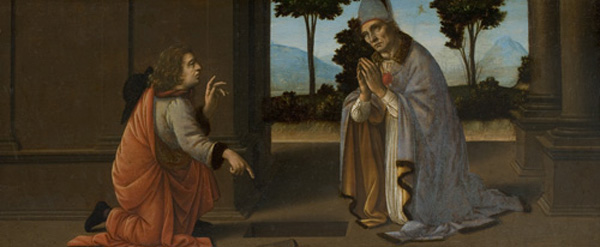Has the unprecedented sale of Leonardo’s Salvator Mundi brought more paintings by the Renaissance master out of the closet? Over the courses of this fall and winter, some people were speculating that that would happen, and also that–of course–none of them would be “right.”
Now the Worcester Art Museum is entering the fray, but with a reasoned case–founded on research and connoisseurship over many years–for a painting it has owned since 1940: A Miracle of Saint Donatus of Arezzo (c. 1479-85), below. The painting is a predella panel of an altarpiece in the Duomo of Pistoia in Tuscany; a second panel, Annunciation, is in the collection of the Louvre. A third seems to be missing.
Saint Donatus, donated to the Worcester museum as a Leonardo but soon downgraded, has been attributed to Lorenzo di Credi since then–but that attribution has bothered Laurence Kanter, Chief Curator at the Yale University Art Gallery, for about 20 years. More recently, it also bothered Rita Alberrson, chief conservator at the Worcester museum, who has studied the painting for about 9-10 years, using 21st century technology. The two of them have been working away on the attribution, and in conjunction with Bruno Mottin, the senior curator of the Centre de Recherche et de Restauration des Musées de France, who has studied Annunciation, below. are prepared to argue that both works are largely by Leonardo.
I wrote all this up for an article for the January issue of The Art Newspaper, making their case more clear with examples. My piece is not online yet–just in the print and digital versions so far. (I have posted it on my website.)
Worcester on March 10 will open an exhibition, The Mystery of Worcester’s Leonardo, of those two works plus one by Lorenzo di Credi–it’s there to show his style, which is incongruous with the two other works. While Kanter is convinced that most, if not all, of Annunciation is by Leonardo, and perhaps 85% of Saint Donatus is by him, the two museums are hedging a bit with their new labels, which will read “Attributed to Leonardo da Vinci and Lorenzo di Credi.”
Go and you’ll be able to see for yourselves.
Photo credits: Courtesy of the Worcester Art Museum and the Louvre


